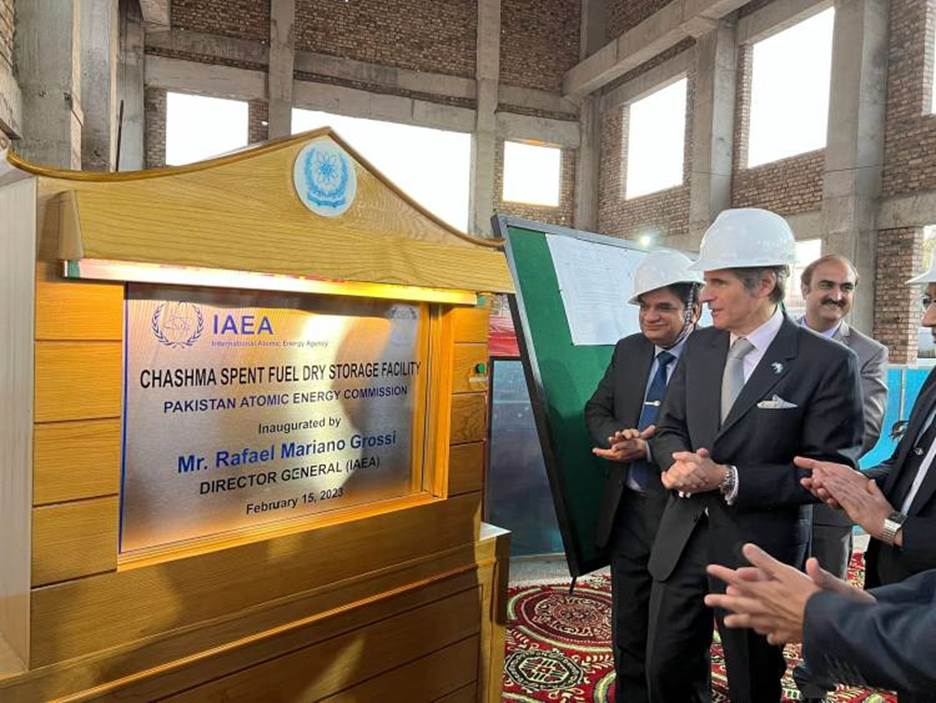

|
IAEA Director General Rafael Mariano Grossi inaugurates the new spent fuel dry storage facility at Chashma Nuclear Power Plant - Photo D. Candano/IAEA |
Pakistan's Large and Growing Civil Nuclear Program
By Riaz Haq
CA

Pakistan's nuclear weapons program gets a lot of global attention. But the country also has a large and growing civil nuclear program which has added over 3,500 MW of low-carbon electricity to the national grid. It also supports a variety of agricultural, biological and medical applications.
The program relies particularly on the expertise and contributions of nuclear scientists trained at the Pakistan Institute of Nuclear Science and Technology (PINSTECH) founded in 1965 by Dr Ishrat Husain Usmani. Dr Usmani graduated from Aligarh Muslim University and later did his doctoral research at London's Imperial College under the supervision of Nobel Laureate Niels Bohr. The entire civilian nuclear program in Pakistan operates under the International Atomic Energy Agency safeguards.

|
PINSTECH, hub of nuclear research in Pakistan |
Pakistan Nuclear Science and Technology History
Pakistan started its nuclear program in the 1950s under the United States’ “Atoms for Peace” program, which was designed to promote peaceful uses of nuclear technology. In 1956, the Pakistani government created the Atomic Energy Commission (PAEC) to lead the new program. The United States gave Pakistan its first reactor—the five megawatt Pakistan Atomic Research Reactor (PARR-1) — in 1962.
During this early period, PAEC chairman Dr Ishrat Husain Usmani devoted government resources to train the next generation of Pakistani scientists. Usmani founded the Pakistan Institute of Nuclear Science and Technology (PINSTECH) in 1965 and sent hundreds of young Pakistani students to be trained abroad.
Nuclear Power Generation
Pakistan has installed over 3,500 MW of low-carbon nuclear power generating capacity. Nuclear power plants in Pakistan generated 15,540 GWH of electricity in 2021, a jump of 66% over 2020.
Overall, Pakistan's power plants produced 136,572 GWH of power, an increase of 10.6% over 2020, indicating robust economic recovery amid the COVID-19 pandemic. Nuclear offers the lowest cost of fuel for electricity (one rupee per KWH) while furnace oil is the most expensive (Rs 22.2 per KWH).
Construction of two 1,100 MW nuclear power reactor K2 and K3 units in Karachi was completed by China National Nuclear Corporation in 2022, according to media reports . Chinese Hualong One reactors installed in Pakistan are based on improved Westinghouse AP1000 design which is far safer than Chernobyl and Fukushima plants.
Nuclear Medicine
Currently, there are 51 nuclear medicine centers in Pakistan, according to National Institutes of Health (NIH) . Pakistan Atomic Energy Commission (PAEC) is the largest single contributor with 18 centers spread across the length and breadth of the country, including some remote towns. In terms of radionuclide therapeutic radioiodine for outpatient treatment of hyperthyroidism is more widely available across Pakistan. Inpatient facilities for delivering high dose are limited, but given the span of centers across the country, a large extent of the country’s landscape is covered.
Shaukat Khanum Cancer Hospital founded by former Prime Minister Imran Khan was the first PET-CT service in Pakistan introduced in the private sector in Lahore in 2009. At present 6 PET/CT centers are operational, 2 in Lahore , 4 in Karachi backed by 5 hospital-based cyclotrons (Lahore 2, Karachi 3).
A cyclotron is a type of particle accelerator which repeatedly propels a beam of charged particles (protons) in a circular path. Medical radioisotopes are made from non-radioactive materials (stable isotopes) which are bombarded by these protons. In the next 2 to 6 months, first PET/CT with onsite cyclotron is expected to commission in Rawalpindi along with a scanner in Peshawar and Lahore taking the tally to 9 scanners. A fourth cyclotron is expected to be operational in Karachi during the same period. All cyclotrons are used for F-18 labeled FDG as it remains the work horse of PET imaging. The optimal half-life, simple chemistry, and tons of experience and literature make it ideal to make a successful enterprise. At present, there is no registry for the utilization of PET-CT across Pakistan; however, institutional clinical experience is increasingly shared at national and international conferences and published in literature, according to the NIH.
Agriculture Applications
Pakistan Atomic Energy Commission (PAEC) has established agriculture and biotechnology centers in the country: Nuclear Institute for Agriculture (NIA) at Tandojam, Sindh (1962); Nuclear Institute for Agriculture & Biology (NIAB) (1972); National Institute of Biotechnology & Genetic Engineering (NIBGE) (1994) at Faisalabad, Punjab; and Nuclear Institute for Food & Agriculture (NIFA), in Peshawar, Khyber Pakhtunkhwa (1982). These institutes focus on crop improvement, pest control, livestock health, food and environmental protection, and soil-water and plant nutrition management.
The research at agriculture and biotech centers has produced several new varieties of wheat, cotton, rice, mung bean, chickpea, lentil, sugarcane, castor bean, kinnow, sesame, tomato, and brassica. These varieties are high-yielding, heat-tolerant, insect- and disease-resistant, and have more nutritional value.
According to a report from the IAEA, mutant varieties of cotton in Pakistan have improved the quality traits of crops. The mutations in the crop varieties have led to “decrease[d] use of pesticides (due to increased disease resistance), a reduction in using fertilizers and consumption of water (due to the highly efficient nutrient intake and better tolerance to drought), superior quality, and higher crop yields,” the report states.
The new varieties developed now account for 40% of all cotton produced in Pakistan, up from just 25% two years ago and from nonexistent yield in 2016, according to Nuclear NewsWire .
International Atomic Energy Agency
Recently, the IAEA Director General Rafael Mariano Grossi visited Pakistan to meet with Pakistani officials in charge of the civilian nuclear program. Here's a press release of the IAEA about the visit:
The Islamic Republic of Pakistan and the IAEA will increase collaboration in peaceful applications of nuclear science and technology, particularly in agriculture and medicine, to the benefit of the country and its neighbors. That was the outcome of Director General Rafael Mariano Grossi’s two-day trip to Pakistan this week, during which he met with the country’s leadership — including its Prime and Foreign Ministers — and visited numerous nuclear facilities across the country, some of which he inaugurated.
Mr Grossi began his visit by meeting with Prime Minister Muhammad Shehbaz Sharif. The two spoke about the worsening effects of climate change on Pakistan and how nuclear science and IAEA support is helping the country.
For decades Pakistan has been ranked as one of the 10 most vulnerable countries to climate change, and last summer, was inundated with climate-change linked flooding which caused mass displacement of people and economic damages to the tune of USD 40 billion. The IAEA and Food and Agriculture Organization of the United Nations (FAO), in coordination and consultation with Pakistani authorities developed an emergency support package to assist the country in applying nuclear science to better understand the flood’s impact on soils, crops and the potential spread of animal and zoonotic diseases.
The Prime Minister expressed his desire to strengthen collaboration with the IAEA in agriculture and medicine and his support to the Agency’s efforts to promote peace and development worldwide. The two also discussed nuclear safety and security in Ukraine, where Mr Grossi is championing efforts to establish a protection zone around Ukraine’s Zaporizhzhya Nuclear Power Plant, a facility beset with nuclear safety and security challenges caused by the war in the country.
In a meeting with Foreign Minister Bilawal Bhutto Zardari, Mr Grossi said opportunities for the peaceful use of nuclear science and technology in Pakistan were plentiful, emphasizing how nuclear applications and IAEA initiatives are addressing climate change and issues of access to cancer care. Mr Bhutto Zardari said that Pakistan and the IAEA will further enhance cooperation and extend the role of nuclear applications in dealing with climate change, water, energy and food security.
In Islamabad, Mr Grossi met with the Minister of Planning and Development, Ahsan Iqbal, to discuss the role of nuclear applications in addressing Pakistan’s vulnerability to climate change. The Director General also met with Pakistani fellows of the IAEA Marie Sklodowska-Curie Fellowship Program, an initiative seeking to help build gender-balanced capacities in the nuclear sector.
Nuclear for energy, food and health
Pakistan currently operates six nuclear power reactors at two sites, that generate about 10 per cent of the country’s total and almost a quarter of its low-carbon electricity. During his trip, Mr Grossi visited one of those sites, Chashma Nuclear Power Plant, 250 kilometers south of Islamabad. Inaugurating the site’s new spent fuel dry storage facility, Mr Grossi highlighted the importance of managing spent fuel safely and securely.
Mr Grossi was welcomed at the Pakistan Institute of Nuclear Science and Technology (PINSTECH), an IAEA partner in work related to human health, nutrition and water analysis. At PINSTECH, Mr Grossi inaugurated a dosimetry laboratory. Mr Grossi also visited the Pakistan Centre of Excellence in Nuclear Security (PCENS), saying he was impressed by the high standard of the facility and that he looked forward to further collaboration.
At the Nuclear Medicine Oncology and Radiotherapy Institute in Islamabad, Mr Grossi inaugurated Cyberknife, a new cancer treatment facility he described as a milestone for the country. He said Pakistan would be able to support its neighbors with regards to cancer treatment access by becoming a regional center under Rays of Hope — an IAEA initiative seeking to increase cancer care access in low- and middle-income countries by helping to introduce and improve radiation medicine capacities and build the cancer care workforce.
In Faisalabad, Mr Grossi visited the Nuclear Institute for Agriculture and Biology (NIAB), designating it as an IAEA Collaborating Centre in agriculture and biotechnology. In a special ceremony, Mr Grossi planted a Sago Palm at the site and spoke about the IAEA’s collaboration with the facility in developing climate change resilient cotton varieties. NIAB is also a national laboratory under the IAEA’s ZODIAC initiative for combating zoonotic diseases and future pandemics.
Mr Grossi toured another IAEA Collaborating Centre, the National Institute of Safety and Security, when visiting the Pakistan Nuclear Regulatory Authority and meeting with its Chairman Faizan Mansoor. He was also honored to inaugurate the National Radiation Emergency Coordination Centre (NRECC) in Islamabad.
Visiting the headquarters of the Pakistan Atomic Energy Commission (PAEC), Mr Grossi had a meaningful exchange with the Commission on the comprehensive and cohesive nature of the country’s peaceful nuclear program. Mr Grossi's visit to Pakistan was on the invitation of PAEC Chairman Raja Ali Raza Anwar, whom he thanked for Pakistan's hospitality during the two days. The Director General concluded his visit in Islamabad with a seminar on climate change mitigation, during which he highlighted the role of the IAEA in supporting climate-vulnerable countries in addressing the climate crisis with nuclear science and technology.
(Riaz Haq is a Silicon Valley-based Pakistani-American analyst and writer. He blogs at www.riazhaq.com )

